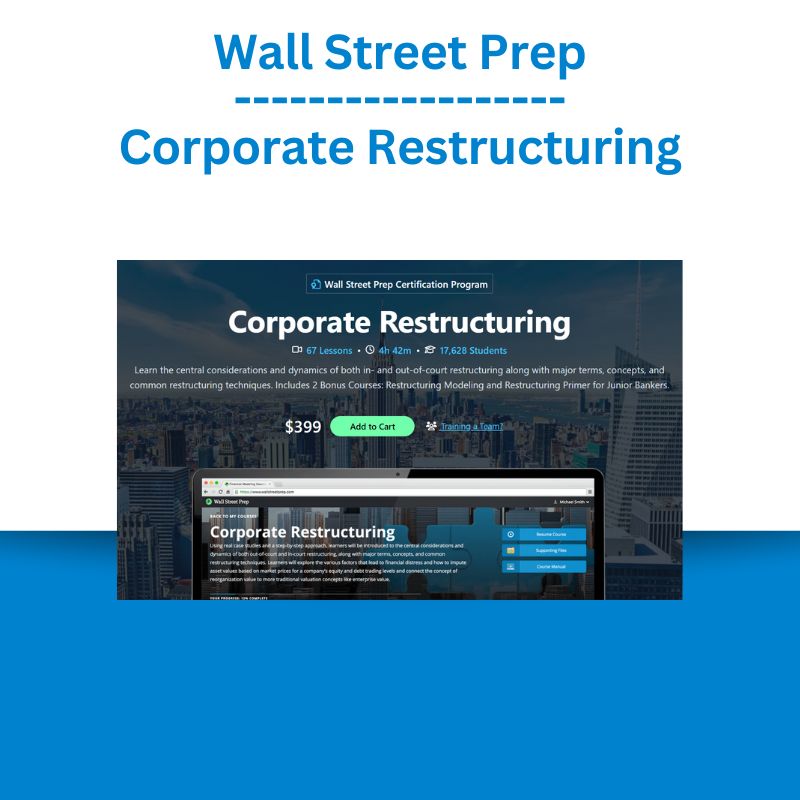*** Proof of Product ***

Exploring the Essential Features of “Wall Street Prep – Corporate Restructuring“
Learn the central considerations and dynamics of both in- and out-of-court restructuring along with major terms, concepts, and common restructuring techniques. Includes 2 Bonus Courses: Restructuring Modeling and Restructuring Primer for Junior Bankers.
Understand the Restructuring and Bankruptcy Process
Step-by-Step Video and Real Case Studies
Using real case studies and a step-by-step approach, you will learn the central considerations and dynamics of both out-of-court and in-court restructuring, along with major terms, concepts, and common restructuring techniques.
Taught by Experienced Restructuring Instructor-Practitioners
This is the same training program Wall Street Prep delivers to restructuring groups at some of the world’s top investment banks. It is taught by former investment bankers who have worked on high-profile corporate restructuring deals.
What You Will Learn
COURSE 1: UNDERSTANDING CORPORATE RESTRUCTURING
The Restructuring & Bankruptcy Framework
- Explore the various factors that lead to financial distress.
- Learn how to impute asset values based on market prices for a company’s equity and debt trading levels.
- Connect the concept of reorganization value to more traditional valuation concepts like enterprise value.
- Understand priority of claims.
- Learn how inter-creditor agreements, secured vs unsecured, maturity and corporate structure all play a role in restructuring outcomes.
- Explore how the competing motivations and interests of the stakeholders in restructuring all impact the process.
Valuation & Recovery Analysis and Distressed M&A
- Dive deeper into common analyses, including valuation based on management projections, liquidity analysis, a recovery waterfall, and potential equity value post emergence.
- Learn how restructuring fits within a variety of strategic alternatives for firms under distress.
- Understand the mechanics of credit bidding and 363 sales
- Model valuation and capital structure scenarios and the impact on recoveries to the various creditors.
BONUS COURSE: RESTRUCTURING MODELING
Model some of the most challenging aspects of a bankruptcy, including:
- Working capital reclassifications such as critical vendors/AP.
- DIP financing, borrowing base and availability calculations, adequate protection payments.
- Balance sheet roll-forward schedules that maintain a consistent link structure to the cash flow statement and increase transparency.
- Fees, rejection claims and CODI.
- Model recoveries at various operating scenarios.
- Construction of a recovery waterfall that can accommodate scenarios that deviate from the absolute priority rule.
- Using conditional formatting and Excel’s native date formulas to sensitize for different filing and emergence date scenarios.
- Avoiding circular references in the model while maintaining model integrity.
- Incorporating best practices for error-proofing, auditing, and model efficiency.
- Understanding how Fresh Start Accounting affects the model.
BONUS COURSE: DEMYSTIFYING RESTRUCTURING INVESTMENT BANKING
- For incoming restructuring bankers and current bankers looking to further their restructuring or distressed debt knowledge.
- Restructuring IB process overview.
- Learn the skills you’ll need early in your IB career.
- Walk through the analyses and modeling-related techniques used by early-career IB analysts and associates using a case-study.
- Assumes little to no prior knowledge of restructuring.
Who is This Program For?
- Restructuring Investment Banking Professionals
- Distressed Debt Investors
- FP&A and Corporate Finance
- Turnaround Consultants & Advisors
- Private Equity Professionals
- Anyone interested in corporate restructuring
What’s Included
Understanding Corporate Restructuring
Using real case studies and a step-by-step approach, learners will be introduced to the central considerations and dynamics of both out-of-court and in-court restructuring, along with major terms, concepts, and common restructuring techniques. Learners will explore the various factors that lead to financial distress and how to impute asset values based on market prices for a company’s equity and debt trading levels and connect the concept of reorganization value to more traditional valuation concepts like enterprise value.
Introduction to Corporate Financial Restructuring
1. A Simple Example
2. Course Downloads
3. Growth Equity Raise
4. GAAP Vs Market Balance Sheet, Part 1
5. GAAP Vs Market Balance Sheet, Part 2
6. GAAP Vs Market Balance Sheet, Part 3
7. Characteristics Of Debt
8. The Party is Over: Financial Distress, Part 1
9. The Party is Over: Financial Distress, Part 2
10. Quantifying Insolvency
11. Restructuring Introduction Review
Restructuring Plan Basics
12. Options Under Distress
13. In-court Vs Out-of-court Restructuring, Part 1
14. In-court Vs Out-of-court Restructuring, Part 2
15. In-court Vs Out-of-court Restructuring, Part 3
16. Out-of-court Restructuring Recovery Analysis, Part 1
17. Out-of-court Restructuring Recovery Analysis, Part 2
18. Restructuring Plan Basics Review
Understanding Priority & Recovery Analysis in Restructuring
19. Treatment Of Claims
20. Priority Of Unsecured Claims
21. DIP Financing
22. Summary – Priority Of Claims And Recovery Waterfall
23. Recovery Waterfall Scenarios, Part 1
24. Recovery Waterfall Scenarios, Part 2
25. Other Restructuring Concepts
26. Castex Recovery Waterfall Example
27. Unallowed Claims Section
28. Restructuring Plan Revisited, Part 1
29. Restructuring Plan Revisited, Part 2
30. Restructuring Plan Revisited, Part 3
31. How Stakeholders May React To The Restructuring Plan
32. Priority & Recovery Analysis Review
Valuation
33. Role Of Valuation In Restructuring
34. Recovery Analysis With Different Valuation And Debt Capacity
35. Collateral Valuation
36. Distressed Debt Investor Perspective
37. Valuation Review
Priority – Additional Considerations
38. Determinants Of Priority: Collateral
39. Determinants Of Priority: Inter-creditor Subordination
40. Determinants Of Priority: Inter-creditor Subordination Exercise
41. Determinants Of Priority: Maturity Of Claim, Part 1
42. Determinants Of Priority: Maturity Of Claim, Part 2
43. Determinants Of Priority: Open Market Purchase Of Debt
44. Determinants Of Priority: Maturity Of Claim Additional Considerations
45. Determinants Of Priority: Corporate Structure, Part 1
46. Determinants Of Priority: Corporate Structure, Part 2
47. Protection Against Structural Subordination
48. Covenants
49. Substantive Consolidation
50. Equitable Subordination
51. Priority – Additional Considerations Review
Plan Confirmation
52. Plan Of Reorganization
53. Plan Approval Must Meet 4 Tests
54. Plan Confirmation Review
Vanguard Natural Resources
55. Vanguard Background
56. Vanguard DIP, Part 1
57. Vanguard DIP, Part 2
58. Vanguard DIP, Part 3
59. Liquidation Analysis
60. Vanguard Projections And Valuation
61. Fulcrum Security
62. Proposed Plan
63. Estimated Recoveries
64. Estimated Recoveries Review
65. Plan Feasibility
Additional Topics
66. Credit Bidding And Stalking Horse10:28
67. Vanguard Resources & Additional Topics Review
Restructuring Modeling
This course is designed to teach restructuring and bankruptcy modeling to students and professionals pursuing careers in restructuring, bankruptcy and distress. Using the Borders bankruptcy as our primary case study, we begin with an overview of the restructuring and bankruptcy framework. Then we will learn to build an advanced bankruptcy model from scratch, incorporating bankruptcy specific elements like DIP financing, the creation of liabilities subject to compromise, working capital drivers, cancellation of debt income, and Fresh Start accounting. We conclude the course with valuation analysis and a recovery analysis, where we will layer various valuation scenarios onto the model to analyze possible recoveries to the various creditors.
Chapter 1: Restructuring Primer
1. Course Downloads
2. Restructuring Overview, Part 1
3. Restructuring Overview, Part 2
4. Restructuring Overview, Part 3
5. Restructuring Overview, Part 4
Chapter 2: Restructuring Modeling Program
6. Introduction
7. Model Structure
8. Model Structure, Part 2
9. Inputting Historicals
10. Forecasting the Income Statement
11. Forecasting Working Capital
12. Forecasting Property, Plant, and Equipment (PP&E)
13. Forecasting Goodwill and Financing Fees
14. Forecasting Accounts Payable
15. Forecasting Accounts Payable, Part 2
16. Forecasting Accounts Payable, Part 3
17. Accrued Liabilities and Other Long Term Liabilities
18. Lease Rejection Claims and Professionals Fees
19. Cleaning up the Balance Sheet and Income Statement
20. Debt Introduction and Modeling Prepetition Term Loans
21. Modeling the Cash Flow Statement
22. Modeling the Prepetition Revolver, Part 1
23. Modeling the Prepetition Revolver, Part 2
24. Modeling the DIP Revolver
25. Referencing Debt Related Forecasts into the CFS
26. Valuation and Debt Capacity
27. Sources and Uses of Funds
28. Modeling the Priority of Claims Waterfall
29. Exit Revolver
30. Debt Reinstatement
31. Modeling the Equity
32. Completing the Model
33. Additional Topics: Fresh Start Accounting
34. Additional Topics: The Thirteen Week Cash Flow
Demystifying Restructuring Investment Banking for Incoming Analysts and Associates
This course is designed for incoming restructuring bankers and current bankers looking to further their restructuring or distressed debt knowledge. It provides an in-depth overview of restructuring and identify the skills you’ll need in the early days of your restructuring IB career. We begin by introducing the restructuring process as well as common pitchbook and financial analyses in restructuring IB. From there, we take more in-depth look at the analyses and modeling-related techniques utilized by analysts and associates early in their restructuring banking careers. This course assumes little to no prior knowledge of restructuring. Less
Demystifying Restructuring Investment Banking for Incoming Analysts and Associates
1. Introduction and Agenda
2. Overview of IB Restructuring Groups and Role of the Analyst Associate
3. Course Downloads
4. High Level Capital Structure Review
5. Overview of Absolute Priority
6. Comparison of Corporate Levered Debt Alternatives
7. Restructuring Case Study Introduction Arch Coal Industry Dynamics
8. Arch Coal Situation and Restructuring Overview
9. Arch Coal Capital Structure (Pre Bankruptcy)
10. Overview of Frequently Utilized Credit Statistics
11. Capital Structure Analyses in Excel
12. Review of Initial Discussion and Next Steps
13. Forecasting Liquidity and Building Initial Assumptions
14. Building Free Cash Flow Projections
15. Building the Debt Schedule and Credit Statistics
16. Wrap Up Free Cash Flow Projections
17. Revisiting the Arch Coal Restructuring Case
18. DIP Financing Discussion
19. Why Invest in the Arch Coal DIP
20. Excel Analysis of Arch Market Implied Asset Value Post Emergence
21. Excel Analysis of Potential First Lien Lender Recovery
22. Arch Coal Restructuring Plan
23. Sourcing Capital Structure Inputs from Public Filings
24. Sourcing Capital Structure Inputs from Market Data
25. Capital Structure Presentation
26. Using the Long Term Debt Footnote to Build the Cap Table in Excel
27. Arch’s 1st Lien Debt: Credit Facilities & Term Loan
28. Arch’s 2nd Lien Notes
29. Arch’s Unsecured Notes
30. Cap Table and Presentation Conclusion
31. Demystifying Restructuring IB Review
Course Highlights
- Used on the Street
This is the same comprehensive course our corporate clients use to prepare their analysts and associates. - Real Case Studies
This course uses actual financial filings to show how restructuring is done in the real world. - Taught by Bankers
Our instructors are former I-bankers who give lessons real-world context by connecting it to their experience on the desk.
Please see the full list of alternative group-buy courses available here: https://lunacourse.com/shop/










 Alphashark - The AlphaShark SV-Scalper
Alphashark - The AlphaShark SV-Scalper  Julie Stoian & Cathy Olson - Launch Gorgeous - Funnel Gorgeous Bundle
Julie Stoian & Cathy Olson - Launch Gorgeous - Funnel Gorgeous Bundle  Forexmentor - Recurring Forex Patterns
Forexmentor - Recurring Forex Patterns  Matthew Kratter - Trader University
Matthew Kratter - Trader University  Trade Like Mike - The TLM Playbook 2022
Trade Like Mike - The TLM Playbook 2022  Emanuele Bonanni - My Trading Way
Emanuele Bonanni - My Trading Way  Ed Ponsi - Forex Trading
Ed Ponsi - Forex Trading  Matan Feldman - The 13-Week Cash Flow Modeling - Wall Street Prep
Matan Feldman - The 13-Week Cash Flow Modeling - Wall Street Prep  Crypto Dan - The Crypto Investing Blueprint To Financial Freedom By 2025
Crypto Dan - The Crypto Investing Blueprint To Financial Freedom By 2025